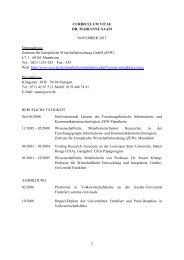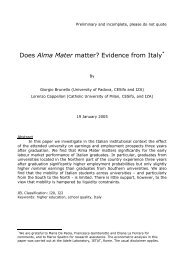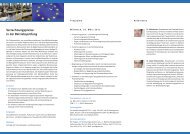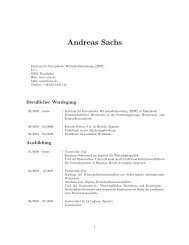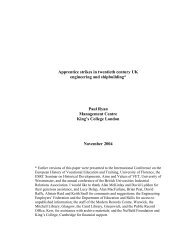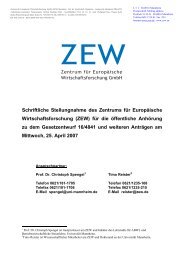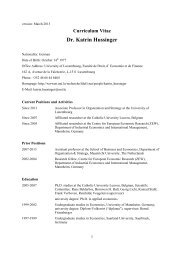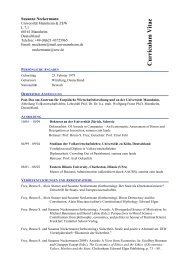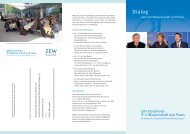Eine empirische Analyse mit kombinierten Individual
Eine empirische Analyse mit kombinierten Individual
Eine empirische Analyse mit kombinierten Individual
Erfolgreiche ePaper selbst erstellen
Machen Sie aus Ihren PDF Publikationen ein blätterbares Flipbook mit unserer einzigartigen Google optimierten e-Paper Software.
Bender, S./Hilzendegen, J./Rohwer, G./Rudolph, H, (1996): Die IAB-Beschäftigtenstichprobe<br />
1975-1990. In: Beiträge zur Arbeitsmarkt- und Berufsforschung 197,<br />
Nürnberg.<br />
Berman, E./Bound, J./Machin, S. (1998): Implications of Skill-Biased Technological<br />
Change: International Evidence. In: The Quarterly Journal of Economics 113 (4),<br />
1245-1279.<br />
Berthold, N./Stettes, O. (2004): Die betriebliche Weiterbildung im organisatorischen<br />
Wandel. In: Jahrbücher für Nationalökonomie und Statistik 224 (4), 399-419.<br />
Bertschek, I./Kaiser, U. (2001): Productivity Effects of Organizational Change:<br />
Microeconomic Evidence. ZEW Discussion Paper 01-32.<br />
Black, S./Lynch, L. (2001): How to Compete: The Impact of Workplace Practices on<br />
Productivity. In: Review of Economics and Statistics 83 (3), 434-444.<br />
Black, S./Lynch, L./Krivelyova, A. (2004): How Workers Fare when Employers<br />
Innovate. In: Industrial Relations 43 (1), 44-66.<br />
Blossfeld, H. P./Hamerle, A./Mayer, K. U. (1985): Ereignisanalyse: Statistische<br />
Theorie und Anwendungen in den Wirtschafts- und Sozialwissenschaften. Campus<br />
Verlag: Frankfurt u.a.<br />
Brenner, M. D./Fairris, D./Ruser, J. (2004): “Flexible” Work Practices and<br />
Occupational Safety and Health: Exploring the Relationship Between Cumulative<br />
Trauma Disorders and Workplace Transformation. In: Industrial Relations 43 (1),<br />
242-266.<br />
Breshnahan, T. F./Brynjolfsson, E./Hitt, L. M. (2002): Information Technology,<br />
Workplace Organization, and the Demand for Skilled Labor: Firm-Level Evidence.<br />
In: The Quarterly Journal of Economics 117 (1), 339-376.<br />
Bryson, A./Forth, J. (2006): The Policy Relevance of Linked Employer-Employee<br />
Data. In: Bryson, A./Forth, J./Barber C. (Hrsg.): Making Linked Employer-<br />
Employee Data Relevant to Policy, DTI Occasional Paper No. 4, 1-8.<br />
Burawoy, M. (1979): Manufacturing Consent: Changes in the Labor Process under<br />
Monopoly Capitalism. Chicago: Chicago University Press.<br />
Capelli, P. (1996): Technology and Skill Requirements: Implications for<br />
Establishment Wage Structures. In: New England Economic Review, 138-154.<br />
Capelli, P./Neumark, D. (2004): External Churning and Internal Flexibility: Evidence<br />
on the Functional Flexibility and Core-periphery Hypotheses. In: Industrial<br />
Relations 43 (1), 148-182.<br />
Capelli, P./Neumark, D. (2001): Do “High Performance” Work Practices Improve<br />
Establishment-Level Outcomes? In: Industrial and Labor Relations Review 54 (4),<br />
737-775.<br />
Capelli, P./Neumark, D. (1999): Do “High Performance” Work Practices Improve<br />
Establishment-Level Outcomes? National Bureau of Economic Research,<br />
Working Paper No. 7374, Cambridge, MA.<br />
Card, D./DiNardo, J. E. (2002): Skill-Biased Technological Change and Rising Wage<br />
Inequality: Some Problems and Puzzles. In: Journal of Labor Economics 20 (4),<br />
733-783.<br />
53




